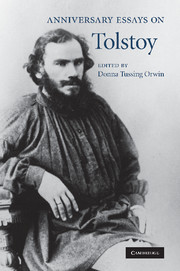Book contents
- Frontmatter
- Contents
- Acknowledgments
- List of contributors
- Introduction
- 1 Tolstoy and music
- 2 Sublime vision and self-derision: the aesthetics of death in Tolstoy
- 3 Tolstoy's peaceable kingdom
- 4 Leo Tolstoy: pacifist, patriot, and molodets
- 5 Leo Tolstoy's correspondence with Nikolai Strakhov: the dialogue on faith
- 6 The worm of doubt: Prince Andrei's death and Russian spiritual awakening of the 1860s
- 7 Tolstoy's spirituality
- 8 Tracking the English novel in Anna Karenina: who wrote the English novel that Anna reads?
- 9 Violence and the role of drama in the late Tolstoy: The Realm of Darkness
- 10 What men quote by: Tolstoy, wise sayings, and moral tales
- 11 The “proletarian lord”: Leo Tolstoy's image during the Russian revolutionary period
- Bibliography
- Index
8 - Tracking the English novel in Anna Karenina: who wrote the English novel that Anna reads?
Published online by Cambridge University Press: 03 May 2010
- Frontmatter
- Contents
- Acknowledgments
- List of contributors
- Introduction
- 1 Tolstoy and music
- 2 Sublime vision and self-derision: the aesthetics of death in Tolstoy
- 3 Tolstoy's peaceable kingdom
- 4 Leo Tolstoy: pacifist, patriot, and molodets
- 5 Leo Tolstoy's correspondence with Nikolai Strakhov: the dialogue on faith
- 6 The worm of doubt: Prince Andrei's death and Russian spiritual awakening of the 1860s
- 7 Tolstoy's spirituality
- 8 Tracking the English novel in Anna Karenina: who wrote the English novel that Anna reads?
- 9 Violence and the role of drama in the late Tolstoy: The Realm of Darkness
- 10 What men quote by: Tolstoy, wise sayings, and moral tales
- 11 The “proletarian lord”: Leo Tolstoy's image during the Russian revolutionary period
- Bibliography
- Index
Summary
England merits the title of most novelistic country … Nowhere does the novel thrive so readily as in England. Dozens of new novels come out every month.
Fatherland Notes, 1866Anna […] asked Annushka to bring out a little lamp, attached it to the armrest of her seat, and took a paper-knife and an English novel from her handbag. At first she was unable to read […] and [then] Anna began to read and to understand what she was reading […] Anna Arkadyevna read and understood, but it was unpleasant for her to read, that is, to follow the reflection of other people's lives. She wanted too much to live herself. When she would read about the heroine of the novel taking care of a sick man, she wanted to walk with inaudible steps round the sick man's room; when she would read about a Member of Parliament giving a speech, she wanted to give that speech; when she would read about how Lady Mary rode to hounds, taunting her sister-in-law and amazing everyone with her courage, she wanted to do it herself. But there was nothing to do, and so, fingering the smooth knife with her small hands, she forced herself to read.
The hero of the novel was already beginning to achieve his English happiness, a baronetcy and an estate, and Anna wished to go with him to this estate, when suddenly she felt that he must be ashamed and that she was ashamed of the same thing.
(Anna Karenina, pt. 1, ch. 29: 99–100; PSS 18: 106–7)- Type
- Chapter
- Information
- Anniversary Essays on Tolstoy , pp. 159 - 182Publisher: Cambridge University PressPrint publication year: 2010



